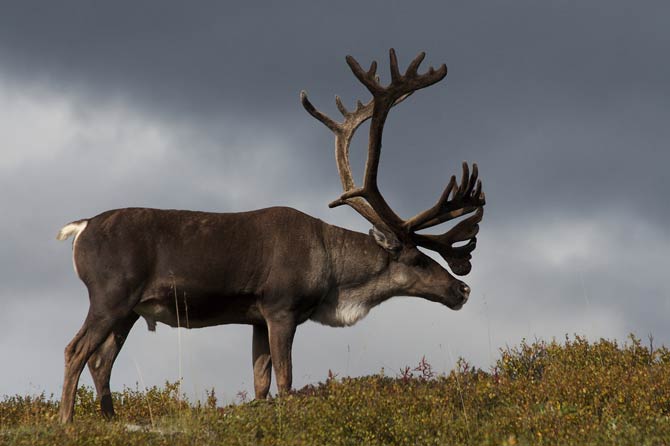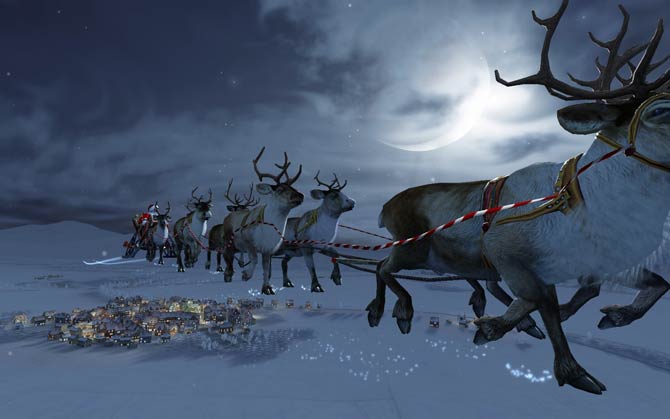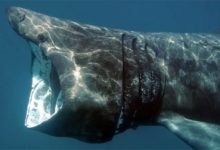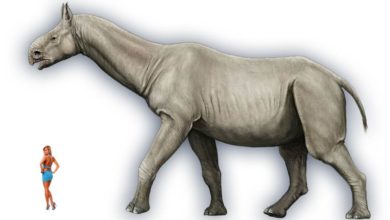Reindeer and Caribou (Rangifer tarandus) – deer from the north
The reindeer is best known for its function during the Christmas season of pulling the Santa Claus sleigh. In fact, this extremely durable animal and loves to travel at speeds of up to 80 km/h (50 mph). It lives in the summer in the tundras and in the winter in the taiga of northern Eurasia and North America as well as on Greenland and other arctic islands. It is the only species of deer that has been domesticated. The North American representatives of the reindeer are known as caribou.

Classification
- Kingdom: Animalia
- Phylum: Chordata
- Class: Mammalia
- Order: Artiodactyla
- Family: Cervidae
- Subfamily: Capreolinae
- Tribe: Rangiferini
- Genus: Rangifer
- Species: Rangifer tarandus
There are as many as 28 subspecies among reindeer. The best known are those living in the northern part of America – called caribou. The individual types of reindeer differ from each other in size and color.

Occurrence
Reindeer are among those animal species that are much more comfortable with the frosty, harsh environment. Consequently, they can be found in the Arctic tundra and forest-tundra in North America and Eurasia.
The largest populations of wild reindeer live in Norway, Finland, Siberia, Greenland, Alaska and Canada.

Characteristic
A characteristic feature of the reindeer is extremely thick fur, which protects the animal from frost. It even covers its mouth to protect it from frostbite while it is feeding. The color of the fur is very individual, depending on the subspecies, individual and season. It is often gray-brown in summer and off-white in winter.
Antlers – not horns
Antlers are a typical element found in deer – they occur in both males and females. It is semicircularly curved and has many branches at its ends.
Every year new antlers are grown for reindeer, and old antlers are usually shed by males in December. Females get rid of it in spring and young ones in summer.
Noses and smell
Like moose, caribou have specialized noses featuring nasal turbinate bones that increase the surface area within the nostrils.

Diet
They feed mainly on lichen, moss, willow and birch leaves, as well as grass. There is also evidence that lemmings and bird eggs sometimes become their food.
Reindeer are ruminants with four stomachs.
Due to the climatic conditions in which the reindeer lives, it can even digest frozen food.

Fights for females and reproduction
The estrus period of reindeer falls in late summer and autumn – from August to November. Male individuals fight for the favors of females in antler duels. The strongest of them can get up to 20 females. Usually, males stop eating at this time and lose a lot of energy reserves.
Gestation lasts from 225 to 235 days. The young are born at the turn of May and June, and are fed on their mother’s milk for six months. Newborns weigh on average 6 kg (13 lb).
Females reach sexual maturity much earlier than males – 18 months after birth. Male specimens only in the age of 3. Reindeer live up to 20 years.

Migrations
Some species of reindeer travel very long distances – the longest of any land mammal.
North American populations travel up to 5,000 km (3,000 mi), which gives a range of as much as 1,000,000 km2 (400,000 sq mi) per year. Other subspecies only move locally.
The migration speed is usually 19-55 km/h (12–34 mph), but caribou can travel at speeds of up to 80 km/h (49.7 mph). It is undoubtedly connected with the fact that the structure of the reindeer legs allows them to run long and persistently.
Reindeer are also good swimmers – usually 6.5 km/h (4 mph) and even 10 km/h (6 mph) if needed.

Threats
Reindeer have to watch out for many predators lurking on them. They are mainly eagles – hunting cubs, bears and wolves.
Protection
Currently, only one variety of reindeer is protected – Peary’s caribou. There are still hunts for other species.
Reindeer and man
Most Eurasian species have been partially domesticated. They perform the functions of the pack, draft and riding animals. They are also a source of meat, skins, bones and milk.

Caribou (Rangifer tarandus caribou) – the cousin of the reindeer
The common name for a North American species of reindeer is caribou. It is most likely a species resulting from the crossing of tundra and forest reindeer. As a result, it reacts differently to habitat degradation and climate change.
The word caribou comes through French, from the Mi’kmaq qalipu, meaning “snow shoveler”.
The name refers to the way the caribou search for food by digging its mouth and hooves in the snow. Its structure, coloration and diet do not differ much from other subspecies of reindeer.
Due to the constant need to search for food, the caribou travels a lot – most of all of the reindeer species.

Caribou societies are very polygamous – there is a harem of up to 40 females for one male.
Unlike its Eurasian relatives, the caribou have never been domesticated.

Reindeer and caribou eye color change
Scientists from Norway and England have discovered the adaptation of reindeer: one part of the reindeer eye changes color in winter and increases the sensitivity of the animal’s eyesight.
The part of the eye in question is tapetum lucidum, a layer of tissue behind the retina that reflects light and helps the animal see better in low light. It is often referred to as “cat’s eye” because it is the layer that causes the eyes of cats and other creatures to glow at night when a small amount of light is directed into the eye. In most mammals, this eye glow is golden. And this is also the case with reindeer in the summer. In winter, however, the reindeer tapetum lucidum turns blue.
The deep blue color is unusual for mammals, and this type of seasonal variation is unique. A switch to blue increases the scattering of reflected light, so it goes to more photoreceptors. This increases the sensitivity of the retina, but at the cost of sharpness, which can be a favorable winter compromise. Reindeer can see a little more, though what they see may not be as sharp. However, it is enough for the reindeer to spot the predator and not be eaten.

Detailed data / dimensions (size)
Reindeer, caribou (Rangifer tarandus)
- Length:
- males: 180–214 cm (71–84 in)
- females: 162–205 cm (64–81 in)
- Height at the withers: 85 to 150 cm (33 to 59 in)
- Weight:
- males: 160–182 kg (352–401 lb); the largest males can weigh up to 318 kg (701 lb)
- females: 80–120 kg (180–260 lb)
- The size of the antlers
- maximum height: 100 cm (3.3 ft)
- width: 135 cm (4.4 ft)
- Tail: 14 – 20 cm (5.5 – 7.9 in)
- Lifespan: up to 20 years
There is a weak sexual dimorphism among reindeer, visible mainly in body weight.

Reindeer and caribou – interesting facts
- Reindeer and caribou are the same species (Rangifer tarandus).
- Caribou is the name of a North American species of reindeer.
- Caribou have been seen licking salt from the road.
- Reindeer are the only mammals that can see ultraviolet light.
- The young drink their mother’s milk 3 minutes after birth, and then every 18 minutes on average.
- Reindeer were supposed to drag Santa’s sleigh.
- The caribou population is believed to have resulted from the amalgamation of two major subspecies of reindeer (tundra and forest reindeer) about 10,000 years ago after the last ice age.
- Today there are around 4 million wild and 3 million domesticated reindeer worldwide. The species is therefore not considered endangered. Three-quarters of the wild reindeer live in North America, and more than three-quarters of the domesticated reindeer in Siberia.
- The reindeer became extinct in the British Isles around 10,000 years ago.



















